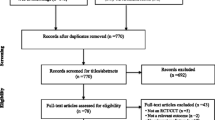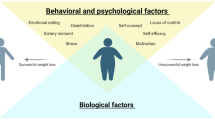Abstract
Objective
Men are currently underrepresented in weight loss trials despite similar obesity rates, which limit our understanding about the most effective elements of treatment for men. The purpose of this study was to test the theoretical (autonomous motivation, self-efficacy, outcome expectancies, and self-regulation) and behavioral (calorie intake, physical activity, self-weighing) mediators of a men-only, Internet-delivered weight loss intervention focused on innovative and tailored treatment elements specifically for men.
Method
Data comes from a 6-month randomized trial (N = 107) testing the intervention compared to a waitlist control group. Changes in the theoretical mediators between baseline and 3 months were tested as mediators of the intervention effect on weight change at 6 months in both single and multiple mediator models. Changes in behaviors between baseline and 6 months were tested in the same manner.
Results
The intervention produced greater weight losses compared to the control group (−5.57 kg ± 6.6 vs. −0.65 kg ± 3.3, p < 0.001) and significant changes (p’s < 0.05) in most of the theoretical and behavior mediators. In multiple mediator models, changes in diet-related autonomous motivation, self-efficacy, and self-regulation all significantly mediated the relationship between the intervention and weight loss. The intervention effect was also mediated by changes in dietary intake and self-weighing frequency.
Conclusions
By testing the theoretical mediators of this intervention in a multiple mediator context, this study contributes to current knowledge related to the development of weight loss interventions for men and suggests that interventions should target diet-focused constructs.



Similar content being viewed by others
References
Flegal KM, Carroll MD, Kit BK, Ogden CL. Prevalence of obesity and trends in the distribution of body mass index among US adults, 1999–2010. JAMA. 2012; 307: 491-497.
Ogden CL, Carroll MD, Curtin LR, et al. Prevalence of overweight and obesity in the United States, 1999–2004. JAMA. 2006; 295: 1549-1555.
Pagoto SL, Schneider KL, Oleski JL, et al. Male inclusion in randomized controlled trials of lifestyle weight loss interventions. Obesity. 2011; 20: 1234-1239.
4. Robertson C, Archibald D, Avenell A, et al. Systematic reviews of and integrated report on the quantitative, qualitative and economic evidence base for the management of obesity in men. Health Technology Assessment. 2014; 18. doi: 10.3310/hta18350.
Williams RL, Wood LG, Collins CE, Callister R. Effectiveness of weight loss interventions- is there a difference between men and women: A systematic review. Obes Rev. 2015; 16: 171-186.
Young MD, Morgan PJ, Plotnikoff RC, Callister R, Collins CE. Effectiveness of male-only weight loss and weight loss maintenance interventions: A systematic review with meta-analysis. Obes Rev. 2012; 13: 393-408.
Lubans DR, Morgan PJ, Collins CE, et al. Mediators of weight loss in the “Healthy Dads, Healthy Kids” pilot study for overweight fathers. Int J Behav Nutr Phys Act. 2012; 9: 45.
Lubans DR, Morgan PJ, Collins CE, Warren JM, Callister R. Exploring the mechanisms of weight loss in the SHED-IT intervention for overweight men: a mediation analysis. Int J Behav Nutr Phys Act. 2009; 6: 76.
Young MD, Lubans DR, Collins CE, et al. Behavioral mediators of weight loss in the SHED-IT community randomized controlled trial for overweight and obese men. Ann Behav Med. 2015; 49: 286-292.
Jeffery RW. How can health Behavior theory be made more useful for intervention research? Int J Behav Nutr Phys Act. 2004; 1: 10.
Crane MM, Lutes LD, Ward DS, Bowling JM, Tate D. A randomized trial testing the efficacy of a novel approach to weight loss among men with overweight and obesity. Obesity. 2015; 23: 2398-2405.
Ryan RM, Deci EL. Self-determination theory and the facilitation of intrinsic motivation, social development, and well-being. Am Psychol. 2000; 55: 68-78.
Bandura A. Social cognitive theory of self-regulation. Organ Behav Hum Decis Process. 1991; 50: 248-287.
Bandura A. Health promotion by social cognitive means. Health Educ Behav. 2004; 31: 143-164.
Silva MN, Markland D, Carraca EV, et al. Exercise autonomous motivation predicts 3-yr weight loss in women. Med Sci Sports Exerc. 2011; 43: 728-737.
Teixeira PJ, Silva MN, Coutinho SR, et al. Mediators of weight loss and weight loss maintenance in middle-aged women. Obesity. 2010; 18: 725-735.
Palmeira AL, Teixeira PJ, Branco TL, et al. Predicting short-term weight loss using four leading health behavior change theories. Int J Behav Nutr Phys Act. 2007; 4: 1-12.
Warziski MT, Sereika SM, Styn MA, Music E, Burke LE. Changes in self-efficacy and dietary adherence: The impact on weight loss in the PREFER study. J Behav Med. 2008; 31: 81-92.
Wingo BC, Desmond RA, Brantley P, et al. Self-efficacy as a predictor of weight change and behavior change in the PREMIER Trial. J Nutr Educ Behav. 2013; 45: 314-321.
Steinberg DM, Tate DF, Bennett GG, et al. The efficacy of a daily self-weighing weight loss intervention using smart scales and email. Obesity. 2013; 21: 1789-1797.
Wing RR, Tate DF, Gorin AA, Raynor HA, Fava JL. A self-regulation program for maintenance of weight loss. N Engl J Med. 2006; 355: 1563-1571.
Anderson ES, Winett R, Wojcik J, Williams D. Social cognitive mediators of change in a group randomized nutrition and physical activity intervention: Social support, self-efficacy, outcome expectations and self-regulation in the Guide-to-Health Trial. J Health Psychol. 2010; 15: 21-32.
Egger G, Mowbray G. A qualitative analysis of obesity and at-risk overweight in working men. Aust J Nutr Diet. 1993; 50: 10-14.
Gough B, Conner MT. Barriers to healthy eating amongst men: A qualitative analysis. Soc Sci Med. 2006; 62: 387-395.
Thomas S, Reading J, Shephard R. Revision of the Physical Activity Readiness Questionnaire (PAR-Q). Can J Sport Sci. 1992; 17: 338-345.
Reinert DF, Allen JP. The alcohol use disorders identification test (AUDIT): a review of recent research. Alcohol Clin Exp Res. 2002; 26: 272-279.
Levesque CS, Williams GC, Elliot D, et al. Validating the theoretical structure of the Treatment Self-Regulation Questionnaire (TSRQ) across three different health behaviors. Health Educ Res. 2007; 22: 691-702.
Clark M, Abrams D, Niaura R, Eaton C, Rossi J. Self-efficacy in weight management. J Consult Clin Psychol. 1991; 59: 739-744.
O’Neil PM, Currey HS, Hirsch AA, et al. Development and validation of the Eating Behavior Inventory. J Psychopathol Behav Assess. 1979; 1: 123-132.
Sallis JF, Pinski R, Grossman R, Patterson T, Nader P. The development of self-efficacy scales for health related diet and exercise behaviors. Health Educ Res. 1988; 3: 283-292.
Paffenbarger R, Hyde R, Wing A, Hsieh C. Physical activity, all-cause mortality, and longevity of college alumni. N Engl J Med. 1986; 314: 605-613.
Ainsworth BE, Haskell WL, Herrmann SD, et al. The Compendium of Physical Activities Tracking Guide. Retrieved September 1, 2013, from https://sites.google.com/site/compendiumofphysicalactivities/
MacKinnon DP, Fritz MS. Required sample size to detect the mediated effect. Psychol Sci. 2007; 18: 233-239.
Hayes AF. Introduction to Mediation, Moderation, and Conditional Process Analysis. New York: The Guilford Press; 2013.
Preacher KJ, Hayes AF. Asymptotic and resampling strategies for assessing and comparing indirect effects in multiple mediator models. Behav Res Methods. 2008; 40: 879.
Jeffery RW, Bjornson-Benson WM, Rosenthal BS, et al. Correlates of weight loss and its maintenance over two years of follow-up among middle-aged men. Prev Med. 1984; 13: 155-168.
French SA, Jeffery RW, Wing RR. Sex differences among participants in a weight-control program. Addict Behav. 1994; 19: 147-158.
Presnell K, Pells J, Stout A, Musante G. Sex differences in the relation of weight loss self-efficacy, binge eating, and depressive symptoms to weight loss success in a residential obesity treatment program. Eat Behav. 2007; 9: 170-180.
Addis ME, Mahalik JR. Men, masculinity, and the contexts of help seeking. Am Psychol. 2003; 58: 5-14.
O’Neil PM, Rieder S. Utility and validity of the eating behavior inventory in clinical obesity research: a review of the literature. Obes Rev. 2005; 6: 209-216.
Zheng Y, Klem ML, Sereika SM, et al. Self-weighing in weight management: A systematic literature review. Obesity. 2015; 23: 256-265.
Pacanowski CR, Levitsky DA. Frequent self-weighing and visual feedback for weight loss in overweight adults. J Obes. 2015; 2015: 9.
Swift DL, Johannsen NM, Lavie CJ, Earnest CP, Church TS. The role of exercise and physical activity in weight loss and maintenance. Prog Cardiovasc Dis. 2014; 56: 441-447.
Wadden TA, Vogt RA, Andersen RE, et al. Exercise in the treatment of obesity: Effects of four interventions on body composition, resting energy expenditure, appetite, and mood. J Consult Clin Psychol. 1997; 65: 269-277.
Collins CE, Morgan PJ, Warren JM, Lubans DR, Callister R. Men participating in a weight-loss intervention are able to implement key dietary messages, but not those relating to vegetables or alcohol: the Self-Help, Exercise and Diet using Internet Technology (SHED-IT) study. Public Health Nutr. 2011; 14: 168-175.
Dhurandhar NV, Schoeller D, Brown AW, et al. Energy balance measurement: when something is not better than nothing. Int J Obes. 2015; 39: 1109-1113.
Acknowledgments
This research was supported by funding provided to M. M. Crane through the Cancer Control Education Program (5R25-CA057726) at Lineberger Comprehensive Cancer Center at The University North Carolina at Chapel Hill and through the Dissertation Completion Fellowship provided by The Graduate School at the University of North Carolina at Chapel Hill. The authors would like to thank Dr. Kurt Ribisl for his assistance in developing and critically evaluating this study while serving on M. M. Crane’s dissertation committee. Clinicaltrials.gov identifier: NCT01843595.
Author information
Authors and Affiliations
Corresponding author
Ethics declarations
Authors’ or Authors’ Statement of Conflict of Interest and Adherence to Ethical Standards
Authors Crane, Ward, Lutes, Bowling, Tate declare that they have no conflict of interest. All procedures, including the informed consent process, were conducted in accordance with the ethical standards of the responsible committee on human experimentation (institutional and national) and with the Helsinki Declaration of 1975, as revised in 2000.
About this article
Cite this article
Crane, M.M., Ward, D.S., Lutes, L.D. et al. Theoretical and Behavioral Mediators of a Weight Loss Intervention for Men. ann. behav. med. 50, 460–470 (2016). https://doi.org/10.1007/s12160-016-9774-z
Published:
Issue Date:
DOI: https://doi.org/10.1007/s12160-016-9774-z




